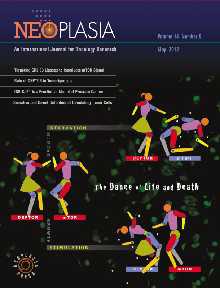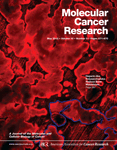J Clin Invest.:DNA修复酶预防炎症诱发的肿瘤
2012-06-17 bo 生物谷
6月11日,J Clin Invest.杂志在线报道了DNA损伤修复酶在炎症与肿瘤中的最新研究进展。世界上超过15%的肿瘤死亡与其伴发的感染或炎症有关。因此,理解炎症如何促进肿瘤发生对于肿瘤的防治具有重要意义。 由于活化的中性粒细胞和巨噬细胞释放活化氧和氮家族(RONS),炎性组织常常具有脂类过氧化造成的亚乙烯基碱基(ε-base)DNA损伤。炎症的促癌变作用,部分是通过RONS诱导的细胞毒和突
6月11日,J Clin Invest.杂志在线报道了DNA损伤修复酶在炎症与肿瘤中的最新研究进展。世界上超过15%的肿瘤死亡与其伴发的感染或炎症有关。因此,理解炎症如何促进肿瘤发生对于肿瘤的防治具有重要意义。
由于活化的中性粒细胞和巨噬细胞释放活化氧和氮家族(RONS),炎性组织常常具有脂类过氧化造成的亚乙烯基碱基(ε-base)DNA损伤。炎症的促癌变作用,部分是通过RONS诱导的细胞毒和突变性DNA损伤(包括ε-base损伤)发挥的。小鼠烷基腺嘌呤DNA转葡糖基酶(AAG,也称为MPG)识别此类碱基损伤,因此可防止炎症相关的结肠癌。另两种DNA修复酶ALKBH2和ALKBH3可修复ε-base损伤。研究者想探索这些DNA加双氧酶可否保护机体免受慢性炎症引发的结肠癌。
利用化学试剂诱导结肠炎和结肠癌的小鼠模型,研究者发现ALKBH2和ALKBH3发挥类似于AAG的防癌效果。更为重要的是,Alkbh2 和 Alkbh3 分别表现出与Aag基因之间的显著异位显性。这3种DNA修复酶的缺陷造成显著的协同效应表型。仅一轮化学诱导性结肠炎就可导致缺乏这3种酶的实验动物死亡。

doi:10.1016/j.cell.2011.10.017
PMC:
PMID:
DNA repair is indispensable for survival after acute inflammation
Jennifer A. Calvo1,2, Lisiane B. Meira1,2, Chun-Yue I. Lee2,3, Catherine A. Moroski-Erkul1,2, Nona Abolhassani1,2, Koli Taghizadeh2, Lindsey W. Eichinger1,2, Sureshkumar Muthupalani4, Line M. Nordstrand5, Arne Klungland5 and Leona D. Samson1,2,6,7
More than 15% of cancer deaths worldwide are associated with underlying infections or inflammatory conditions, therefore understanding how inflammation contributes to cancer etiology is important for both cancer prevention and treatment. Inflamed tissues are known to harbor elevated etheno-base (ε-base) DNA lesions induced by the lipid peroxidation that is stimulated by reactive oxygen and nitrogen species (RONS) released from activated neutrophils and macrophages. Inflammation contributes to carcinogenesis in part via RONS-induced cytotoxic and mutagenic DNA lesions, including ε-base lesions. The mouse alkyl adenine DNA glycosylase (AAG, also known as MPG) recognizes such base lesions, thus protecting against inflammation-associated colon cancer. Two other DNA repair enzymes are known to repair ε-base lesions, namely ALKBH2 and ALKBH3; thus, we sought to determine whether these DNA dioxygenase enzymes could protect against chronic inflammation-mediated colon carcinogenesis. Using established chemically induced colitis and colon cancer models in mice, we show here that ALKBH2 and ALKBH3 provide cancer protection similar to that of the DNA glycosylase AAG. Moreover, Alkbh2 and Alkbh3 each display apparent epistasis with Aag. Surprisingly, deficiency in all 3 DNA repair enzymes confers a massively synergistic phenotype, such that animals lacking all 3 DNA repair enzymes cannot survive even a single bout of chemically induced colitis.
本网站所有内容来源注明为“梅斯医学”或“MedSci原创”的文字、图片和音视频资料,版权均属于梅斯医学所有。非经授权,任何媒体、网站或个人不得转载,授权转载时须注明来源为“梅斯医学”。其它来源的文章系转载文章,或“梅斯号”自媒体发布的文章,仅系出于传递更多信息之目的,本站仅负责审核内容合规,其内容不代表本站立场,本站不负责内容的准确性和版权。如果存在侵权、或不希望被转载的媒体或个人可与我们联系,我们将立即进行删除处理。
在此留言














#EST#
50
#DNA修复#
52